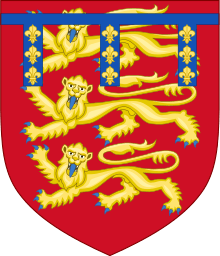Maud, Countess of Leicester
Maud of Lancaster (4 April 1340 – 10 April 1362), also known as Matilda, Countess of Hainault, was a 14th-century English noblewoman who married into the Bavarian royal family.
The eldest daughter of Henry of Grosmont, 1st Duke of Lancaster and Earl of Leicester, and his wife Isabel de Beaumont, she was born at Bolingbroke Castle in Lindsey.
Marriages
She was married firstly to Ralph Stafford, whilst still a child. Following his death, she married secondly, in 1352, to William V, Count of Holland, Zeeland and Hainault, a member of the Wittelsbach Bavarian royal family.
Inheritance
| English Royalty |
| First House of Lancaster |
|---|
 Armorial of Plantagenet |
| Henry, 1st Duke |
The Duchy of Lancaster (First Creation) became extinct upon her father's death in 1361, however Maud became co-heiress, with her sister Blanche of Lancaster, to her father's estates and remaining titles. The title Earl of Leicester passed to her second husband who was confined due to insanity from 1358 until death in 1389, whilst the Earldom of Lancaster passed to her younger sister's husband, John of Gaunt. Maud died a year later without surviving issue (her only child, a daughter by William V, having died in 1356), so the remainder of her father's inheritance passed to Blanche and John of Gaunt upon her death. That inheritance provided the political and financial foundation of the House of Lancaster, with the Lancastrian King Henry IV of England being Maud's nephew.
Ancestry
| Ancestors of Maud, Countess of Leicester | ||||||||||||||||||||||||||||||||||||||||||||||||||||||||||||||||||||||||||||||||||||||||||||||||||||||||||||||||||||||||||||||||||||||||||||||||||||||||||||||||||||||||||||||||||||||||||||||||||||||||||||||||||||||||||||||||||||||||||||||||||||||||||||||||||||||||||||||||||||||||||||||||||||||||||||||||||||||||||||||||||||||||||||||||||||||||||||||||||||||||||||||||||||||||||||||||||||||||||||||||||||||||||||||||||||||||||||||||||||||||||||||||||||||||||||||||||||||||||||||||||||||||||||||||||||||||||||||||||||||||||||||||||||||||||||||||||||||||||||||||||||||||||||||||||||||||||||||||
|---|---|---|---|---|---|---|---|---|---|---|---|---|---|---|---|---|---|---|---|---|---|---|---|---|---|---|---|---|---|---|---|---|---|---|---|---|---|---|---|---|---|---|---|---|---|---|---|---|---|---|---|---|---|---|---|---|---|---|---|---|---|---|---|---|---|---|---|---|---|---|---|---|---|---|---|---|---|---|---|---|---|---|---|---|---|---|---|---|---|---|---|---|---|---|---|---|---|---|---|---|---|---|---|---|---|---|---|---|---|---|---|---|---|---|---|---|---|---|---|---|---|---|---|---|---|---|---|---|---|---|---|---|---|---|---|---|---|---|---|---|---|---|---|---|---|---|---|---|---|---|---|---|---|---|---|---|---|---|---|---|---|---|---|---|---|---|---|---|---|---|---|---|---|---|---|---|---|---|---|---|---|---|---|---|---|---|---|---|---|---|---|---|---|---|---|---|---|---|---|---|---|---|---|---|---|---|---|---|---|---|---|---|---|---|---|---|---|---|---|---|---|---|---|---|---|---|---|---|---|---|---|---|---|---|---|---|---|---|---|---|---|---|---|---|---|---|---|---|---|---|---|---|---|---|---|---|---|---|---|---|---|---|---|---|---|---|---|---|---|---|---|---|---|---|---|---|---|---|---|---|---|---|---|---|---|---|---|---|---|---|---|---|---|---|---|---|---|---|---|---|---|---|---|---|---|---|---|---|---|---|---|---|---|---|---|---|---|---|---|---|---|---|---|---|---|---|---|---|---|---|---|---|---|---|---|---|---|---|---|---|---|---|---|---|---|---|---|---|---|---|---|---|---|---|---|---|---|---|---|---|---|---|---|---|---|---|---|---|---|---|---|---|---|---|---|---|---|---|---|---|---|---|---|---|---|---|---|---|---|---|---|---|---|---|---|---|---|---|---|---|---|---|---|---|---|---|---|---|---|---|---|---|---|---|---|---|---|---|---|---|---|---|---|---|---|---|---|---|---|---|---|---|---|---|---|---|---|---|---|---|---|---|---|---|---|---|---|---|---|---|---|---|---|---|---|---|---|---|---|---|---|---|---|---|---|---|---|---|---|---|---|---|---|---|---|---|---|---|---|---|---|---|---|---|---|---|---|---|---|---|---|---|---|---|---|---|---|---|---|---|---|---|---|---|---|---|---|---|---|---|---|---|---|---|---|---|---|---|---|---|---|---|---|---|---|---|---|---|---|---|---|---|---|---|---|---|---|---|---|---|---|---|---|---|---|---|---|---|---|---|---|---|---|---|---|---|---|---|---|---|---|---|---|---|---|---|---|---|---|---|---|---|---|---|---|---|---|---|---|---|---|---|---|---|---|---|---|---|---|---|---|---|
| ||||||||||||||||||||||||||||||||||||||||||||||||||||||||||||||||||||||||||||||||||||||||||||||||||||||||||||||||||||||||||||||||||||||||||||||||||||||||||||||||||||||||||||||||||||||||||||||||||||||||||||||||||||||||||||||||||||||||||||||||||||||||||||||||||||||||||||||||||||||||||||||||||||||||||||||||||||||||||||||||||||||||||||||||||||||||||||||||||||||||||||||||||||||||||||||||||||||||||||||||||||||||||||||||||||||||||||||||||||||||||||||||||||||||||||||||||||||||||||||||||||||||||||||||||||||||||||||||||||||||||||||||||||||||||||||||||||||||||||||||||||||||||||||||||||||||||||||||
References
Citations
- Weir, Alison (1999). Britain's Royal Families: The Complete Genealogy. London: The Bodley Head. pp. 74–76.
- Mosley, Charles, ed. (1999). Burke's Peerage and Baronetage. 1 (106th ed.). Crans, Switzerland: Burke's Peerage (Genealogical Books) Ltd. pp. 227–228.
- Burke, John (1831). A general and heraldic dictionary of the peerages of England, Ireland, and Scotland, extinct, dormant, and in abeyance. England. H. Colburn & R. Bentley. p. 118. Retrieved 17 July 2018.
- Mosley, Charles, ed. (2003). Burke's Peerage, Baronetage & Knightage. 1 (107th ed.). Wilmington, Delaware, U.S.: Burke's Peerage (Genealogical Books) Ltd. p. 1385.
- Cokayne, G.E.; Gibbs, Vicary; Doubleday, H.A.; White, Geoffrey H.; Warrand, Duncan; de Walden, Lord Howard, eds. (2000). The Complete Peerage of England, Scotland, Ireland, Great Britain and the United Kingdom, Extant, Extinct or Dormant. II (new ed.). Gloucester, U.K.: Alan Sutton Publishing. pp. 59–60.
- Angot, A. (1914). "Les vicomtes du Maine". Bulletin de la Commission historique et archéologique de la Mayenne (in French) (30): 19 – via Archives départementales de la Mayenne.
- Purey-Cust, Arthur Perceval (1896). The Heraldry of York Minster. 2. R. Jackson. p. 54. Retrieved 17 July 2018.
Sources
- Mosley, Charles (ed.) Burke's Peerage and Baronetage, 106th edition. (Crans: Burke's Peerage, 1999) vol. 1, p. 228.
- Weir, Alison. Britain's Royal Families: The Complete Genealogy (London: The Bodley Head, 1999), p. 76.
| Preceded by Ingeborg of Mecklenburg-Schwerin |
Duchess of Bavaria 1352–1362 |
Succeeded by Margaret of Brieg |